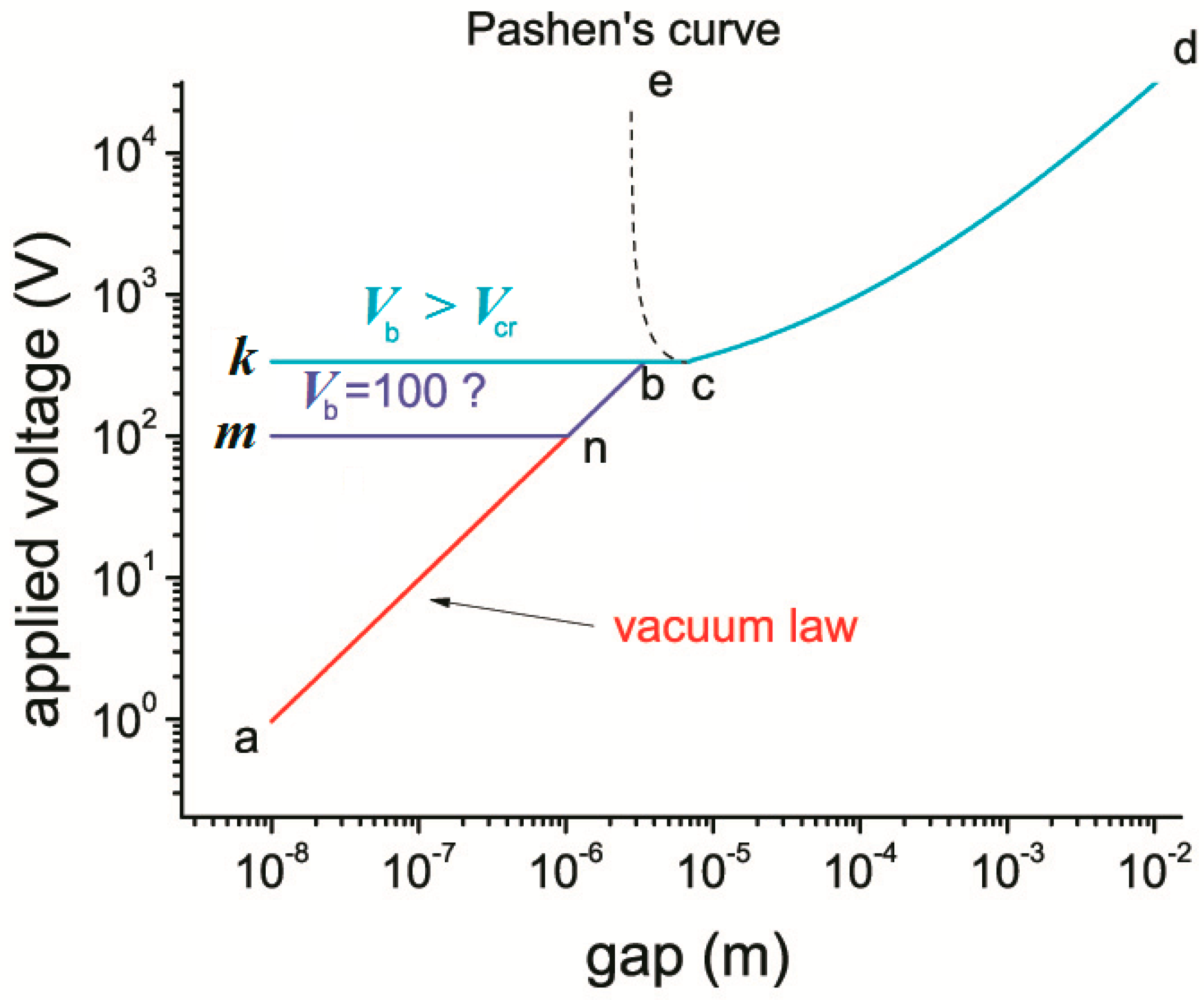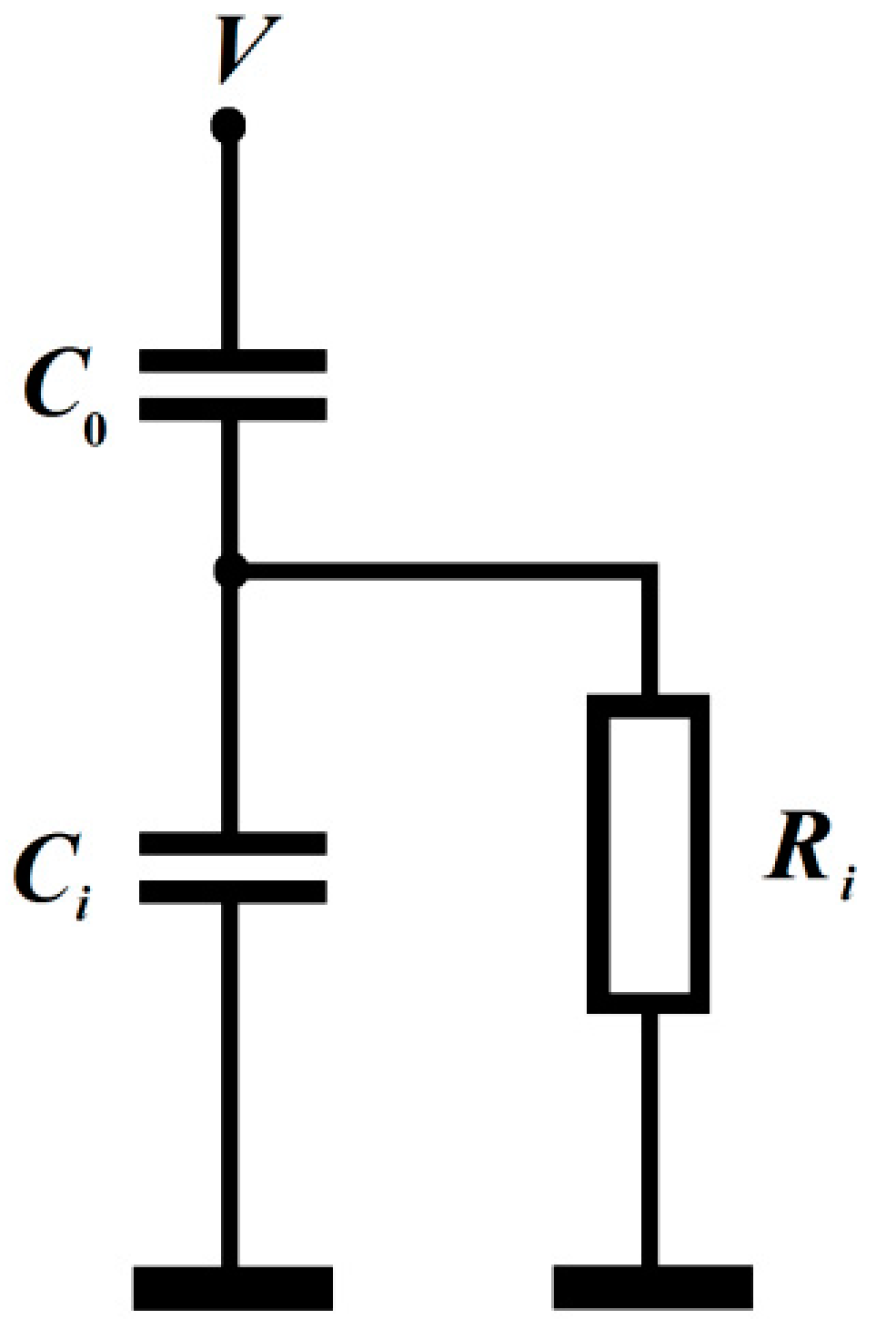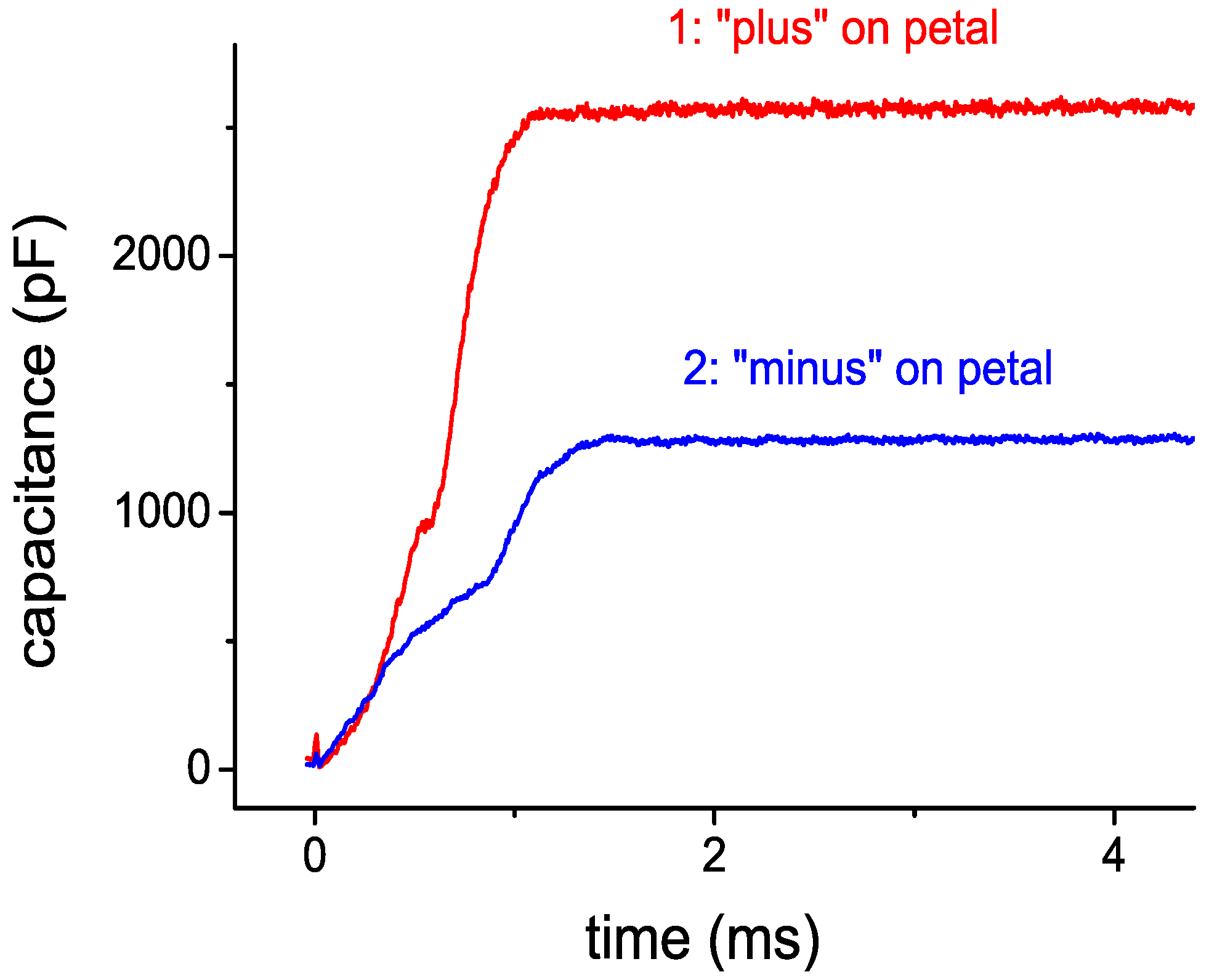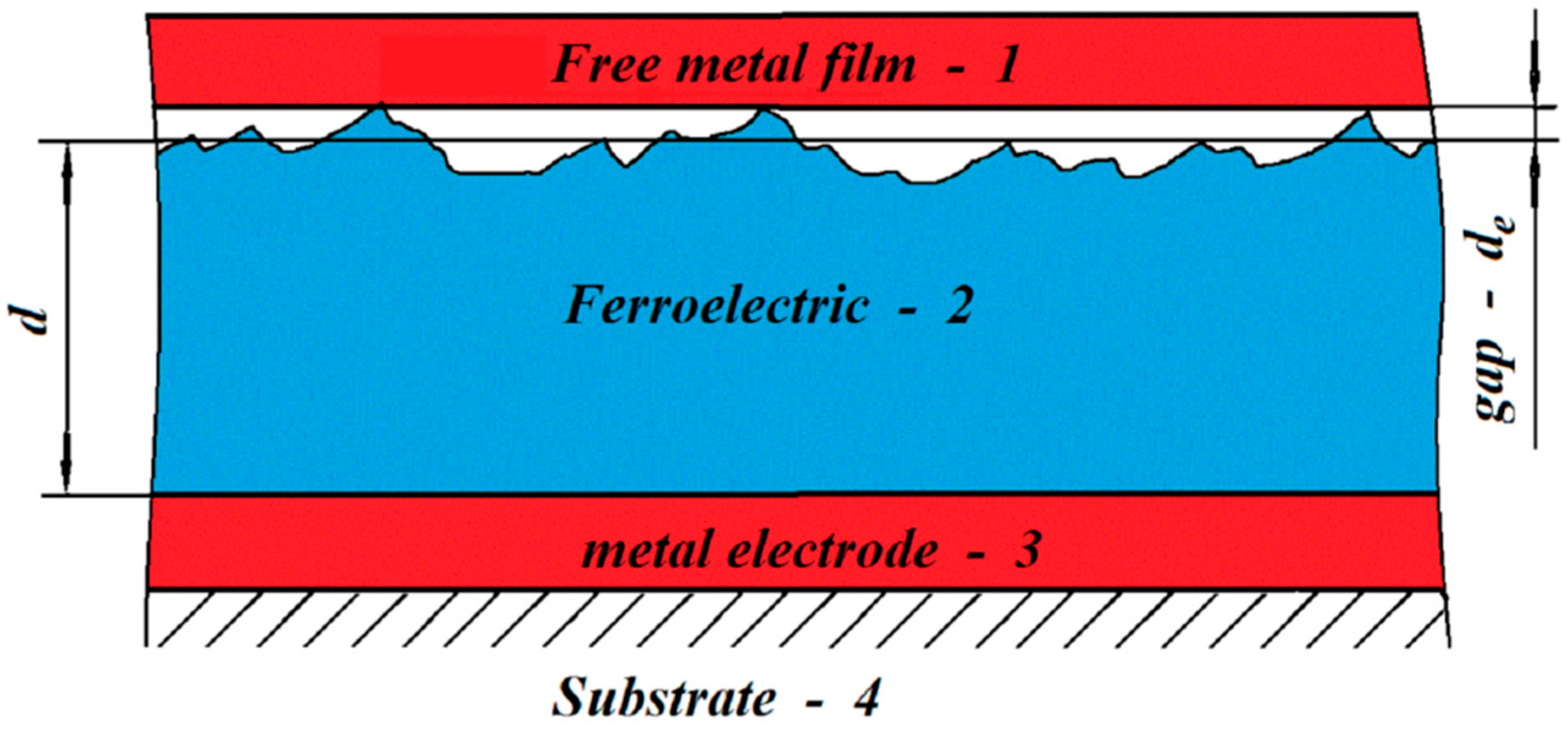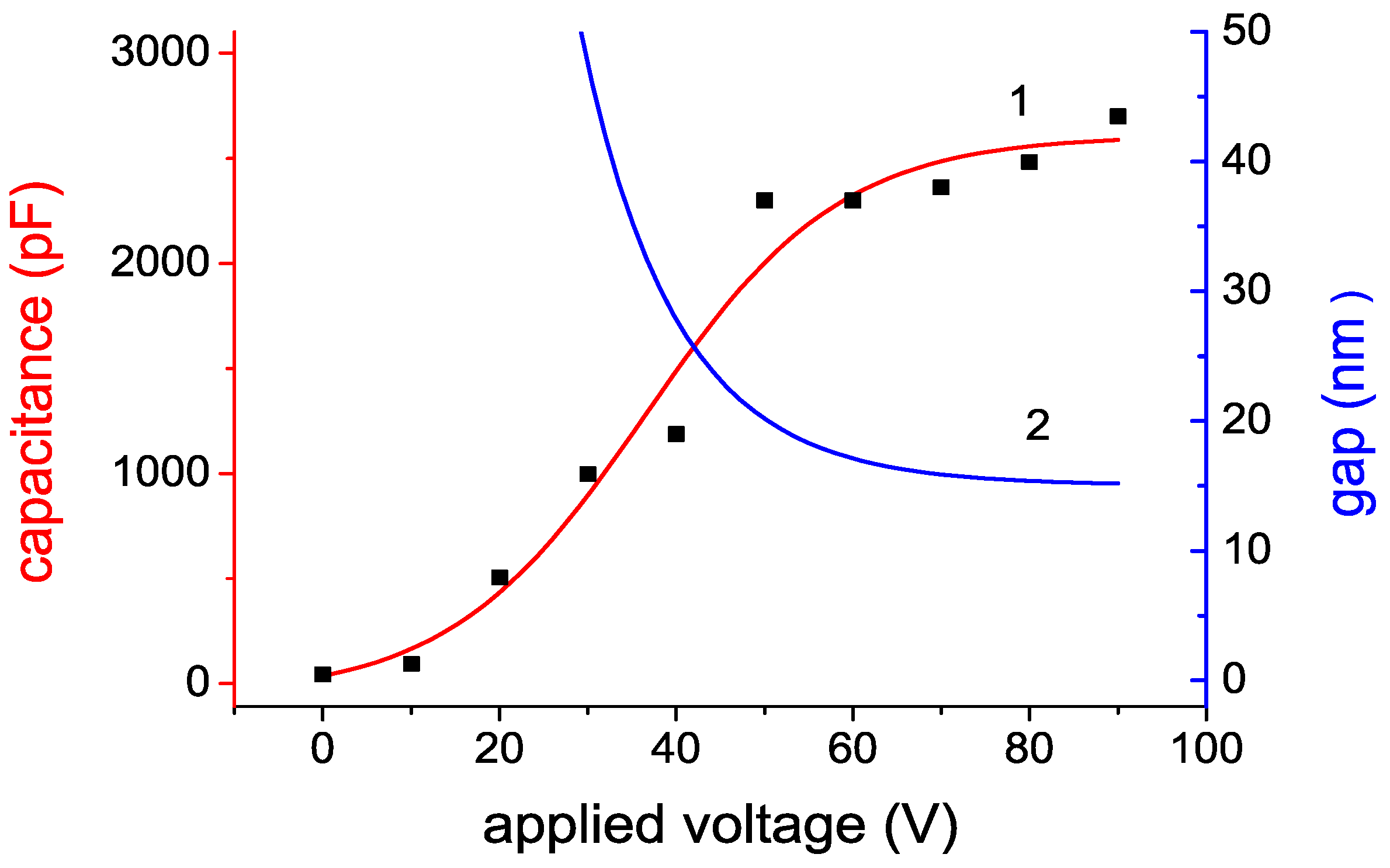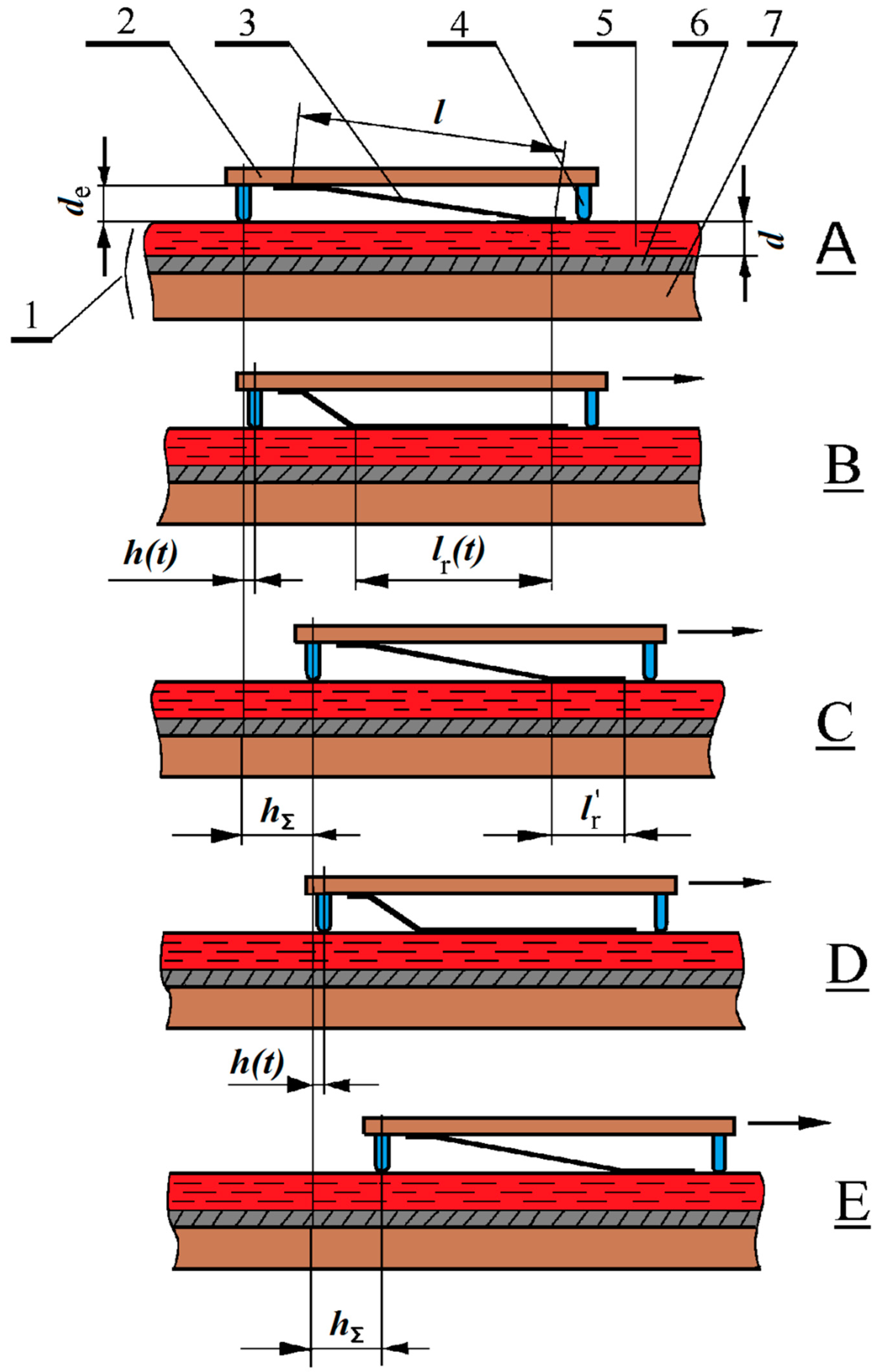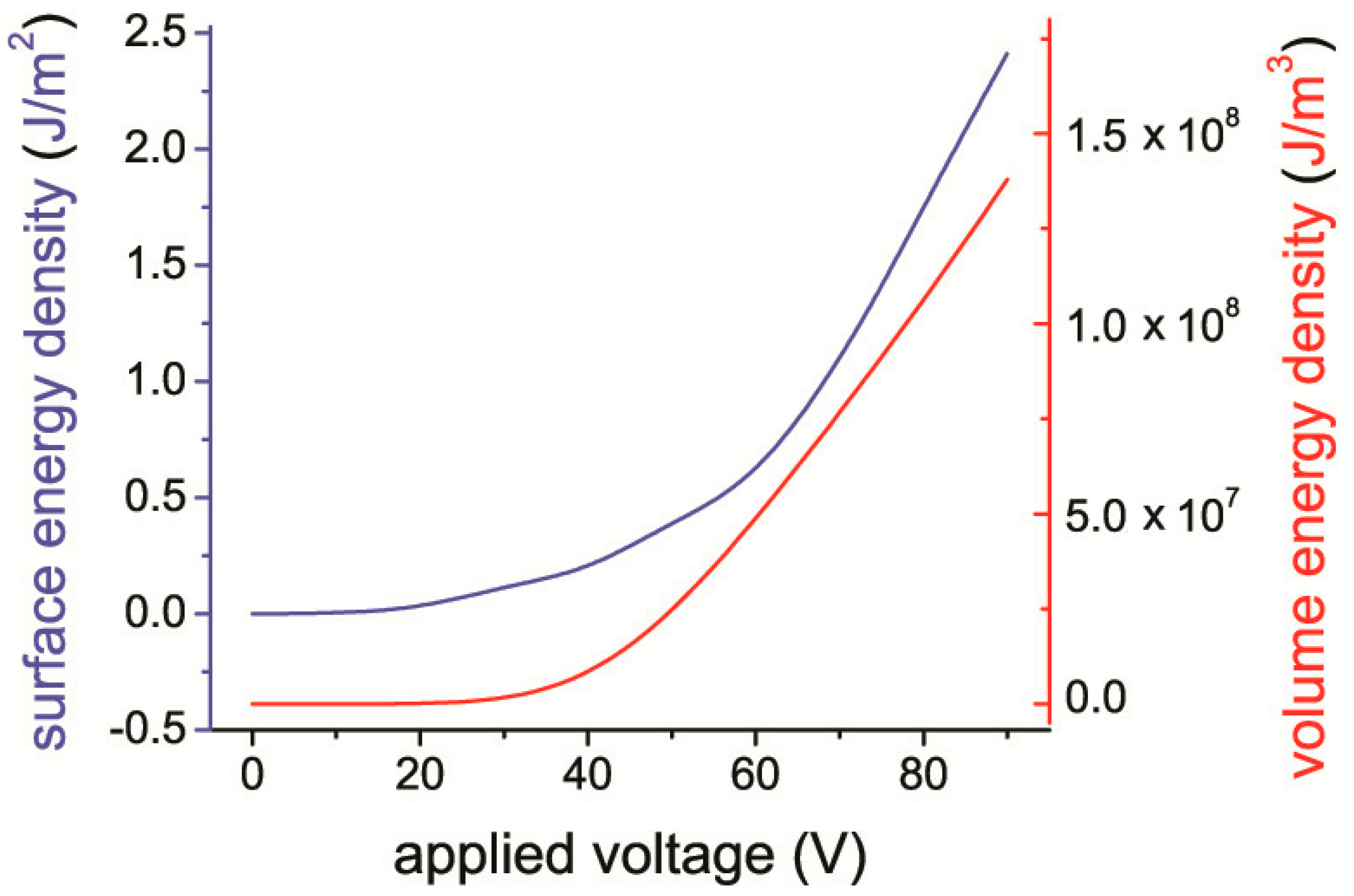3.1. Estimation of the Limiting Energy Density in Electromechanical Converters
The maximum energy density WS,max in the capacitive energy converter under consideration is determined by the following parameters: the minimum gap between the surfaces of the moving electrode and the ferroelectric de,min (and, accordingly, the maximum capacitance of the gap layer Ce,max) and the maximum voltage Vmax. Vmax is the voltage that can be applied to a MFGM-structure without its breakdown and without the onset of currents in the gap, that result in charge accumulation on the surface of the ferroelectric and, consequently, in the field decrease in the gap Ee.
The breakdown of both air and vacuum gaps in the metal-gap-metal (MGM) structure was studied quite intensively. А large number of papers devoted to the breakdown of micron and submicron gaps was published earlier, see, for example, reviews in [
12,
13,
14].
Studies of the MGM structures show that at atmospheric pressure, starting from gaps of 7 μm and less, there is a deviation from the classical Paschen breakdown law (ecd curve,
Figure 1): The dependence of the critical voltage
Vcr, which in this case is equal to the breakdown voltage of the structure
Vb, from the gap width
de is a plateau (bc curve on the
Vcr(
de) curve). Then At
de < 3 μm
Vcr decreases linearly with decreasing
de from
Vi = 330 V in the plateau region to 1 V at
de = 10 nm, curve ab [
12] (see curve abcd in
Figure 1). This behavior of
Vcr is explained by the change in the breakdown mechanism: from impact ionization described by the Paschen law (curve ecd) to the breakdown by the vacuum mechanism (curve ab), which is typical for small gaps at which the ionization length exceeds the width of the gap. Under the conditions of the vacuum mechanism the breakdown is determined by a sharp increase in the concentration of electrons injected from micro-spikes on the electrode surface [
15]. In particular, when micro-spikes are smoothed out by melting, the breakdown voltage increases several times [
16,
17], remaining relatively small in magnitude.
For the out-of-plane structures nanometer-sized minimum gaps are possible. Let us consider the features of the operation of such energy converters.
MDGM-structure can be represented as a serial connection of two capacitances of the dielectric layer
CF and the air gap
Ce,
Figure 2. In this case, the voltage drop across the air gap is expressed as:
In the case when CF<<Ce or dF/ε>>de, we have Ve<<V. So, the most part of the voltage applied to the structure falls on the dielectric layer. Since the dielectric constant of linear dielectrics usually does not exceed 2–10, if the dielectric thickness is about 2–20 μm, which is necessary to prevent breakdown of the structure, reducing the gap to values less than 1 μm will reduce the fraction of voltage applied to the gap. In this case, as de decreases, the energy density WV, calculated in accordance with Equation (1), does not increase, since the field in the gap does not change and is equal to:
The total energy per unit area
WS (see Equation (2)) decreases in accordance with the decrease in the voltage drop across the gap:
Thus, to increase the energy density, as well as the total energy of a capacitive energy converter by reducing the gap between the surfaces of the moving electrode and the dielectric the opposite condition should be fulfilled: CF >> Ce or dF/ε << de. In this case, almost all the voltage is applied to the gap: Ve ≈ V. Since the thickness of the dielectric should be in the range of a few microns (according to the conditions for maintaining the electrical strength of the structure), its dielectric constant must be higher than 1000. This means that in order to reach high energy in converters based on MDGM structures, it is necessary to use ferroelectric thin films with a high dielectric constant value as a dielectric layer. In this case the de value can be reduced to 5–20 nm.
Let us estimate the maximum electric field strength
Emax in the nano-gaps of these structures and the maximum energy density. It is clear that this value should be dependent on the polarity of the voltage applied to the moving electrode if the values of field strength in the nanogap are very high. At negative voltages the current of autoelectron emission flowing from the ME surface through a tunnel-transparent gap to the surface states of the ferroelectric film may occur, giving rise to field screening in the nano-gap by charge accumulation on this surface. Such a process was previously observed experimentally in the study of the memory effect in structures based on thin films of silicon nitride with a sublayer of a tunnel-transparent layer of silicon dioxide [
18]. When electrostatic micromotors have been investigated (see [
19]), this effect manifested itself in charge accumulation at the gap-ferroelectric interface even when sufficiently small (less than 50 V) negative voltages were applied to the moving electrode of the MFGM structure. In particular, the force of electrostatic attraction of ME to the surface of a ferroelectric decreases leading to a corresponding decrease in the capacitance of the structure, as compared with the case of positive displacement, see
Figure 3. Note that for micromotors the effect of charge accumulation in the ferroelectric layer causes the slider to slow down up to total shutdown.
If the mobile electrode is at a positive potential relative to the opposite electrode, then the mechanisms limiting the magnitude of the field in the gap are the effects of field evaporation of metal atoms from the electrode surface and electron tunneling directly from the ferroelectric valence band [
20,
21]. According to estimates, the magnitude of the field, starting from which these effects are significant, is
Ecr = 6 × 10
10 V/m [
20,
21].
It is easy to show that for parameters characteristic for a ferroelectric film: ε/d = 109 (μm)−1 or CF = 8.85 × 10−3 F/m2, the field in the gap of 5 nm in width can reach 1010–6 × 1010 V/m. Then, in the absence of field screening in the gap (for example, when the structure is placed in vacuum) and with a sufficiently high breakdown voltage of the ferroelectric layer, the maximum density of electrical energy in the nanogap of the MFGM structure is equal to WV,max = 1.6 × 1010 J/m3, see Equation (1), and the energy per unit area can reach WS,max = 80 J/m2, respectively.
Thus, the value of WV,max for the considered capacitive converters exceeds the energy density of the inductive converters by 4 orders of magnitude. It is also easy to show (see Equation (2)) that for conventional electrostatic generators on MGM structures the value of total energy WS,max, comparable to that estimated above for MFGM-structures, can be reached only with an interelectrode gap equal to 2 m and the applied voltage of 106 V.
3.2. Peculiarities of Operation of the Electromechanical Transducer in the Modes of Limiting High Energy Density in the Nanogap
Let us consider electromechanical transducers in which the gap is modulated by the movement of ME from the minimum (nanometer) value
de,min to a certain value
de,max. Depending on the conditions in the environment, there are two possible modes of operation of the energy converter based on the MFGM structure, which we will further call as “atmospheric” and “vacuum”. For the atmospheric mode, when the minimum gap changes from nanometer values of
de,min during ME oscillations with amplitudes
de,max exceeding
de,cr = 3 μm, the air ionization in the gap occurs, starting from
Ve =
Vi, see
Figure 1, which is absent in the vacuum mode. The vacuum mode can also manifest itself at atmospheric air pressure, when the impact ionization length exceeds the maximum width of the gap, i.e. with the ME oscillation amplitude being less than
de,cr.
Under conditions of the atmospheric mode, and when the breakdown voltage of a ferroelectric
Vb is less than the minimum voltage on the Paschen curve
Vi, the dependence of the maximum possible voltage in the MFGM structure on the gap size is described by the curve mnbcd,
Figure 1. If
Vb >
Vi, then as the gap increases starting from 3 μm to 7 μm air is ionized in the gap by the impact ionization mechanism. It leads to the formation of a screening charge on the surface of the ferroelectric, which reduces the power consumption of the converter. In this case, the electric field in the gap, see [
22], is expressed as:
where
QS is the charge on ME,
VP =
QP/
CF,
QP is the charge accumulated at the gap-dielectric boundary. The attraction force of the electric field acting on the moving electrode is:
and the energy converted in the structure is:
It is clear, that the process of charge accumulation
QP will be stopped, when the voltage drop across the gap
Ee ×
de (see Equation (7)) reaches the impact ionization potential
Vi, when:
Therefore, in the case under consideration, the energy conversion is described by the curve kcd,
Figure 1, and the maximum energy produced during the conversion cycle is:
where:
Thus, the critical voltage Vcr is equal to Vb when ferroelectric films with a high value of ε are used in MFGM structures and under the conditions Vb < Vi,. As the applied voltage reaches this value, a breakdown of the structure occurs. When Vb > Vi, the critical voltage is calculated by Equation (10), it is equal to the ionization potential Vi. When this voltage is exceeded, impact air ionization in the gap begins, leading to the formation of a charge that screens the field in the gap.
Let us estimate the maximum density of electrical energy that can be reached in converters based on MFGM structures. Assuming that de = 5 nm, d = 1 μm, ε = 1000 (or ε/d = 109 m−1, CF = 8.85·10−3 F/m2) and taking into account that Vi = 330 V, we obtain: de* = 6 nm, C = 1.48 × 10−3 F/m2 and WS,max = 80 J/m2 and WV,max = 1.6 × 1010 J/m3, correspondingly.
Note that these estimates of the limiting energies
WS,max and
WV,max coincide with their values for the vacuum breakdown mode and at a gap size of 5 nm, when the energy is limited by some critical field in the gap
Ecr. When
Ee >
Ecr the evaporation of metal atoms from the surface of PE by the electric field starts. According to [
20,
21], the value of this field can be estimated as 6 × 10
10 V/m. In particular, for atoms of copper, lanthanum and zinc, it is equal to 3 × 10
10 V/m, for tungsten atoms it reaches 10
11 V/m. It can be noted that there are no restrictions on the value of
WS,max in this mode associated with the ionization of air in the gap, so it increases with the growth of the gap width, see Equation (2):
with the bulk energy density
WV,max = 1.6 × 10
10 J/m
3 being constant.
In this case, the parameters limiting the growth of
WS,max are both the electrical strength of the ferroelectric, limiting the voltage applied to the MFGM structure, and the increase in the conduction current in the gap, which screens the field in it. The conduction current through the nanogap increases starting from some critical width
de,cr, at which the ion-electron emission current arises [
23]. The mechanism of this emission lies in the injection of electrons from the valence band of a ferroelectric into the vacuum gap when a metal ion pulled by the field from the moving electrode strikes the surface of the ferroelectric. Since it is known [
23] that such emission begins at an ion velocity
v of the order of 10
7 m/s, then, based on the energy balance, the critical gap value will be equal to:
In particular, for the copper atom
de,cr = 50 nm.
Thus, in the vacuum mode, it is possible to increase, practically by an order of magnitude, the values of the energy WS,max, compared to the atmospheric mode.
3.3. Examples of Practical Implementation of Energy Converters on MFGM-Structures. Experimental Evaluation of Maximum Energy Density
An example of a MFGM structure with a nano-gap created using the electrostatic attraction of a free metal film to the surface of a ferroelectric [
19,
24] is shown in
Figure 4. The minimum size of the gap is determined both by the dimensions of microspikes on the surface of the ferroelectric (ranging from 5 to 50 nm), and by the force of electrostatic attraction of the metal film to the surface, which depends on the amplitude of the applied voltage,
Figure 5, see [
25].
The design of an electrostatic micromotor, which was developed by us earlier [
19,
24,
25,
26,
27]. Some of these designs were patented [
28,
29].
Figure 6, can serve as an example of an energy converter based on a MFGM structure with a nano-gap that develops high mechanical forces.
The operation of such micromotors is based on the successive attraction by electrostatic forces (section by section) of a free metal film (petal) to the ferroelectric surface with an electrode underlayer deposited on the substrate resulting in the formation of a nanometer gap, see
Figure 6.
The stationary plate (stator) I consists of the silicon substrate 7 with the electrode 6 and ferroelectric film 5 deposited on it’s surface. The moving plate (rotor) 2 is separated from the stator by the gap 4. The metallic petals 3 with the length equal to I are synthesized on the rotor’s surface. Rotor moves with respect to the stator along the guides 4.
When the pulse is applied between the petal 3 having it’s initial position A and the electrode 6, the part of the petal is rolled to the ferroelectric surface (state B). The metallic film bends, stretches and transfers the movement to the plate 2, thus carrying out the electromechanical energy conversion. The rolling length lr(t) increases as the voltage pulse acts, and, therefore, rotor’s shift h(t) varies with the voltage pulse duration t. After the end of voltage pulse action the petal under the effect of the elastic force comes to it’s initial position A (with a single voltage pulse) or to the new position C, typical to the continuous rotor movement (when a series of the pulses is applied to the sample),and the rotor is moving by means of inertia to the distance hΣ. The duration of this process defines space between the voltage pulses, i.e. the maximum frequency of these pulses, of order (ρ is the specific weight of petal material, dP is te petal width, l is it length, EY – Yong’s modulus), and, consequently, the power output of the micromotor. When the second voltage pulse is applied to the sample the moving plate with the petals makes one more step and comes to the position D. After the end of the pulse under the effect of the inertia the rotor comes to position E (and the petals’ configuration comes to the state analogous to C).
When the third and further pulses come, the movement occurs in the similar way: ftom position B to position C with the corresponding movement of the plate 2 This work describes the basic characteristics of the electrostatic micromotors and the peculiarities of their functioning in the step mode.
Based on the parameters indicated in
Figure 5, it is possible to estimate the energy accumulated in the gap of the structure under consideration, for example, at a voltage of 90 V, see
Figure 7. It is equal to 2.5 J/m
2. Extrapolating the value of the total energy
WS(V) to voltage equal to
Vi = 330 V, and assuming that
WS increases quadratically with increasing voltage, we get
WS,max = 32 J/m
2. Note that this is a lower estimate, since the dependence
WS(V) is stronger than a quadratic one, because the gap decreases with increasing voltage.
We also have found experimentally that these micromotors reached an energy density of
WS = 1 J/m
2 with a
V value of 50 V [
19]. Assuming that this energy density with the rise of voltage increases proportionally to
V2 and extrapolating this value to
Vmax = 330 V, we get
WS,max = 40 J/m
2, which is two times less than the value of
WS,max theoretically estimated above.
The value of the maximum power density, per unit weight of the structure, which can be reached for the described micromotors, is calculated as:
where
f0 is determined by Equation (17),
ρ1 is the specific weight of the material of the substrates of stator and slider,
h is the total thickness of the substrates,
k is the surface filling ratio by metal petals. Taking
k = 0.8,
dP ≈ 1.5 μm,
l = 100 μm,
h = 1 mm and taking into account that the petals are made of beryllium bronze and the substrates are made of silicon, we get
f0 ≈ 100 kHz and
Pm = 4.3 × 10
6 W/kg. This value of
Pm exceeds the specific power of inductive engines by 3 orders of magnitude: the maximum value of
Pm for high-speed inductive engines is 5 × 10
3 W/kg, [
30,
31].
Estimates of the strength of the petals necessary to reach the limiting density of the converted energy WS,max = 80 J/m2, show that their thickness can be within 1.5–2 microns. Such thicknesses can be easily achieved technologically.
